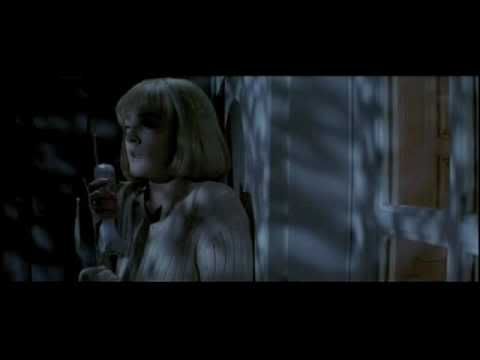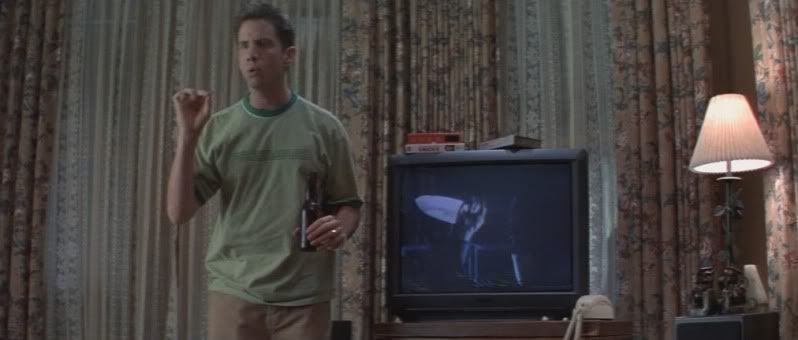Scream was a highly entertaining bundle of postmodern references and genre conventions that no one would believe could have worked so well together.
 |
| Fig. 2 Genre conventions. |
If you were to read the synopsis of Scream, it would not be surprising if it seemed like another slasher horror film that's genre was tired out a long while before this film was released. However, the writer of Scream is well aware of the conventions and clichés that are associated with this genre of film and it seeks they're sought a way to challenge your expectations of it. As the audience watches Scream it is clear that everything you see on the screen has been done before (even the big twist at the end) but, again, the writers are well aware of this, and they use it to their advantage. George Ochoa expressed that "Consistent with its postmodern style, there is little of genuine originality. What was new in Scream was to bring self-refentiality to the slasher film in such a thoroughgoing and playful way." (Ochoa, 2011:139) It is the film's obvious 'playful' nature towards its source material that makes it so thoroughly enjoyable. One example is the opening sequence, in which the audience is introduced to the 'virginal' character. Blonde haired, dressed all in white she is the symbol of the 'final girl' in the slasher genre. The 'final girl' refers to the innocent, non-drinking, non-sexually active female within the narrative that is able to fight the killer and survive because of her innocence. However, the character in Scream, that has all the signs of the 'final girl' is the first one we see get brutally murdered. In Landscapes of Postmodernity, it is explained that "this scene is a reflection of and on postmodern reality, in which signs not only influence the way we perceive the world we live in, but rather replace any fixed conceptions of reality altogether." (Eckhard, Höbling, Fuchs, 2010:72) This reality was created by the audience's experience of the horror genre. They see a blonde virginal girl and they assume she will survive to fight the killer but in fact she is just another victim. The writer has deliberately subverted this genre convention because they know it was seen in the majority of films of this type and they also know the audience will not expect it. Dominic Strinati believes that "These films [Scream franchise] are self-reflexive and knowing about the conventions of the genre in the way postmodern theory suggests. They rely on the tacit understanding that both film makers and audiences know how such films work and they therefore produce and appreciate them because of self-conscious knowledge." (Strinati, 2000:109) One of the reasons this film, and the Scream movies that follow, is so successful is because it takes so much from previous films within the genre but it uses these to create something new. The writer references so many varied elements of previous slasher movies that it is no longer an element from another film, it now acts as a nod to the audience members that can spot them, and they will feel satisfied in knowing that their experiences and enjoyment of the genre is shared by the director and writer of the film.
 |
| Fig. 3 Randy explains the rules. |
There are many references to various horror films in Scream and it is the intertextuality that makes the narrative so compelling. Ochoa believed that "Scream was full of ironic wit and postmodern references to other horror movies - even references to references" (Ochoa, 2011:139) The most prominent 'reference to a reference' is the intertextuality with the film Halloween (1978). Scream takes not only visual but also narrative and audible references from it too. In Scream, one of the lead character's surname is Loomis, which is also the surname of a character from Halloween, which in turn is referencing a character with the same name from Alfred Hitchcock's Psycho (1960). This is a fairly obscure reference that would fly over the head of any normal viewer, but to the experienced watcher of the horror genre this would be a fantastic little nod to them and the films they have enjoyed. Matt Hills explained that "the Scream franchise also offers the possibility of repeated intertextual recognitions to horror fans. By doing so it pleasurably flatters and interpellates its fan audience without alienating non-fan, genre audiences who can still participate in the ride, and who can pick up on more obviously self-reflexive aspects such as the way in which relevant clips of Halloween are intercut or integrated with Scream's diegetic actions" (Hills, 2005:192) There are many possibilities for 'repeated intertextual recognitions' in Scream, but there are different layers of this postmodern borrowing from the genre. Some of the references, as I previously mentioned, are quite obscure but there are still plenty that someone new to the genre would be able to understand. As Hills mentioned, visual clips from Halloween are actually seen in the film (see figure 3) alongside the introduction to 'the rules of horror movies'. Christopher Sharett expressed that "Scream exemplifies the insularity of the genre's pastiche in its reliance upon the viewer's sense of mastery of the form in order to entertain. Rather than referring out, the genre refers in, and rewards its viewers for doing so." (Sharett, 1999:278) It is in the scene from figure 3 that the audience gets a great example of the 'insularity' of the film's pastiche. The character Randy explains to his friends, and to the audience, the rules of a horror film. These reveal who would normally die, who would survive and why. This is a very broad reference as any member of the audience that has ever seen a horror film will be able to appreciate the rules and agree with Randy. He has a clear understanding of the genre as the audience does and as he is part of a horror film this reference is in fact internal rather than external. This leaves the audience both entertained and a little concerned as the rules have not entirely been adhered to yet, the opening scene saw to that.
Wes Craven is a director well experienced in the horror genre. His and the writers enjoyment of it is clear to see in Scream as they twist and bend the audience's expectations. It is because of this that Scream is such an enjoyable and thrilling film. It not only rewards its audience with references and quotes from the characters that they themselves are aware of, but it still manages to be a horror film in its own right. Ochoa said that "To this day whenever a character in a horror movie says something like, "This is just like what happens in horror movies," the success of Scream is behind it." (Ochoa, 2011:139). It started a whole genre of its own, but it will definitely be a difficult film to match both in quality and in intertextual references.
List of Illustrations
Figure 1. Scream (1997) Scream poster. At: http://www.movieposterdb.com/posters/10_06/1996/117571/l_117571_51355a32.jpg (Accessed on: 13/10/11)
Figure 2. Scream (1997) Genre conventions. At: http://img.youtube.com/vi/PJ4ZyHu0-DQ/0.jpg (Accessed on: 13/10/11)
Figure 3. Scream (1997) Randy explains the rules. At: https://blogger.googleusercontent.com/img/b/R29vZ2xl/AVvXsEiu6H60jtIpNPb2_T-b4wrAli_qWIcQFnyO9M0AZnEfq2T8NuZNUYjP53TkFQhGfLexEGP4wPJx8TJ3vvFHvLLGhH711gtgOnv64XJxIqKmeflhWuVWS58lelfWA8e3GQ3PWZacpk6RLeUR/s1600/scream_356.jpg (Accessed on: 13/10/11)
Bibliography
Ochoa, George (2011) Deformed and Destructive Beings: The Purpose of Horror Films. USA: McFarland & Company, Inc.
Sharrett, Christopher (1999) Mythologies of violence in postmodern media. USA: Wayne State University Press.
Hills, Matt (2005) The pleasures of horror. London: Continuum
Rockoff, Adam (2002) Going to pieces: the rise and fall of the slasher film, 1978-1986.
Strinati, Dominic (2000) An introduction to studying popular culture. London: Routledge
Eckhard, Petra, Höbling, Walter, Fuchs, Michael (2010) Landscapes of Postmodernity: Concepts and Paradigms of Critical Theory. USA: Transaction Publishers.
P.S. I'm not sure if this is too waffly or if I'm saying the same thing more than once, but hopefully not! :)



articulate, confident, evidence-based, 'my happy face' :D
ReplyDelete